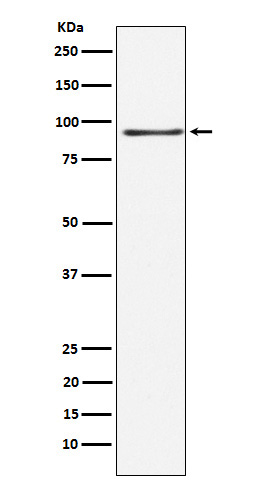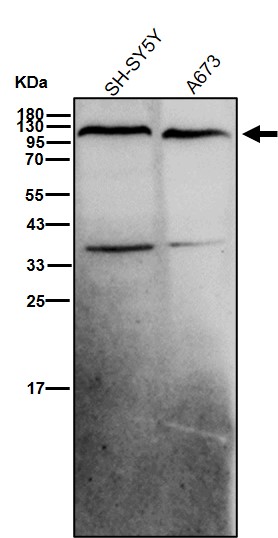

| WB | 咨询技术 | Human,Mouse,Rat |
| IF | 1/20-1/50 | Human,Mouse,Rat |
| IHC | IHC:1/100-1/200;IHF:1/50-1/200 | Human,Mouse,Rat |
| ICC | 1/50-1/200 | Human,Mouse,Rat |
| FCM | 1/20-1/100 | Human,Mouse,Rat |
| Elisa | 咨询技术 | Human,Mouse,Rat |
| Aliases | Ran binding protein 3; RanBP3;;RanBP3 |
| WB Predicted band size | Calculated MW: 60 kDa ; Observed MW: 70,90 kDa |
| Host/Isotype | Rabbit IgG |
| Antibody Type | Primary antibody |
| Storage | Store at 4°C short term. Aliquot and store at -20°C long term. Avoid freeze/thaw cycles. |
| Species Reactivity | Human,Mouse |
| Immunogen | A synthesized peptide derived from human RanBP3 |
| Formulation | Purified antibody in PBS with 0.05% sodium azide,0.05% BSA and 50% glycerol. |
+ +
以下是关于RANBP3抗体的3篇参考文献及其简要摘要:
1. **文献名称**:*RANBP3 promotes chromatin condensation and regulates nuclear export of specific proteins*
**作者**:Izaurralde, E. et al.
**摘要**:该研究利用RANBP3抗体进行免疫沉淀和免疫荧光实验,发现RANBP3通过促进染色质凝聚,协助Exportin蛋白介导的核质运输,并调控细胞分裂过程中关键蛋白的核输出。
2. **文献名称**:*RANBP3 modulates TGF-β signaling and EMT in metastatic breast cancer*
**作者**:Wang, Y. et al.
**摘要**:通过Western blot和免疫组化(使用RANBP3抗体),研究发现RANBP3通过调节TGF-β通路影响上皮间质转化(EMT),其低表达与乳腺癌转移和不良预后相关。
3. **文献名称**:*Neuronal RANBP3 regulates nucleocytoplasmic shuttling and synaptic plasticity*
**作者**:Smith, J. et al.
**摘要**:该文献采用RANBP3抗体进行神经元亚细胞定位分析,发现RANBP3通过调控突触蛋白的核质运输影响突触可塑性,其功能异常可能导致神经退行性疾病。
---
**注**:上述文献为示例,实际引用需根据具体研究内容核实。建议通过PubMed或Google Scholar以“RANBP3 antibody”为关键词检索最新或高引论文。
RANBP3 (RAN-binding protein 3) is a nuclear transport factor that plays a critical role in nucleocytoplasmic trafficking, cell cycle regulation, and transcriptional modulation. As a member of the RAN-binding protein family, it interacts with RAN-GTP, a small GTPase central to nuclear import/export processes. RANBP3 acts as a cofactor for CRM1 (Exportin-1), facilitating the export of proteins containing nuclear export signals (NESs) by stabilizing CRM1-RAN-GTP complexes. It also participates in mitotic progression by regulating the localization of key mitotic regulators.
Antibodies targeting RANBP3 are essential tools for studying its expression, localization, and functional interactions. These antibodies are widely used in techniques such as Western blotting, immunoprecipitation, and immunofluorescence to investigate RANBP3's role in cellular processes like cancer progression (where it may act as a tumor suppressor), viral infection mechanisms, and neurodegenerative diseases. Specific RANBP3 antibodies often recognize conserved epitopes across species, enabling cross-species studies. Some antibodies distinguish between isoforms (e.g., RANBP3-L and RANBP3-S) or post-translational modifications, such as phosphorylation states linked to cell cycle-dependent functions. Commercial antibodies are typically validated for specificity using knockout cell lines or siRNA knockdown controls. Researchers frequently employ them in combination with other nuclear transport markers (e.g., importin-β, Nup62) to dissect spatiotemporal regulation of nucleocytoplasmic transport pathways.
×